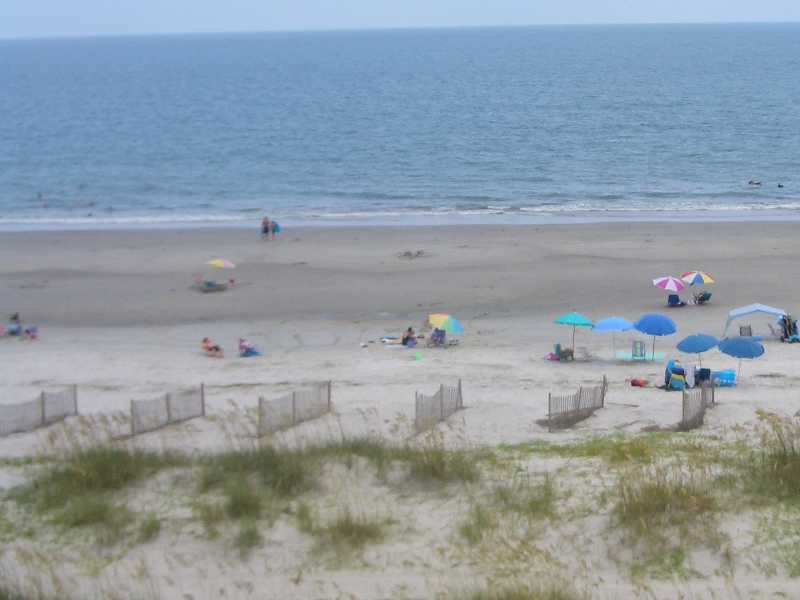

I once spent Christmas Week at Hilton Head Island, and it was...well, it was an experience. I'm not entirely sure what kind of an experience, but an experience it was, no question about that. Mrs Outdoorsman, a/k/a She Who Must Be Obeyed had decreed this trip, and truth to tell, I wasn’t averse to going. Every Christmas season, I ponder the advantages of becoming a Muslim or a Jew to avoid the hoopla; and it seemed like a good opportunity to check out a possible alternative to Long Beach NC, a small resort town where we go every summer. In the event, however, Hilton Head turned out to be nothing like what I expected: I thought I was going to spend a week at “the beach,” but HHI is only theoretically “the beach,” as far as I’m concerned.
We left our innocent and unsuspecting doggies in the hands of the two elderly lesbian ex-nuns who run our local boarding kennel. Each dog has a different reaction to the kennel. Tessa, the Lab, doesn't mind it so much, because except for the fact that she can't sleep on our bed, it's pretty much like home. She eats and sleeps and poops, and that's about the sum of it. Meg, the Border Collie, dislikes it but puts up with it because she is in a cage with her old pal Tessa, and besides, The Master Wills Me To Be Here And He Is Never Wrong. Now that she's getting up in years the inactivity and lack of Frisbee time isn't so hard on her as it was when she was younger, but on the whole she would rather be home. Tycho, the psychotic Siberian Husky, hates the place and the two ladies with a deep passion, and has yet to accept Fate as a dog should. When we fetch them on our return, he’s always hysterically penitent for whatever it was that he did that caused him to be confined to Arfschwitz and promises never to do it again. He hates it so much that I have to go in and get him out of the cage myself because the ladies are afraid to do it: after a week he’s decided he’s been condemned and might just as well take one of them with him.
The drive to HHI was uneventful, even though half of it was in North Carolina. Anyone who has driven any distance in North Carolina knows that "uneventful" is an adjective not normally applied to a road trip through that state. North Carolina will give a driver's license to anyone who asks for one: there seem to be no requirements for driving beyond having a body temperature above 58 degrees. Tycho could get a North Carolina driver's license and he wouldn't be much worse a driver than most NC licensees. Meg would be significantly better than most: she’s pretty intelligent when it comes to moving objects. Possibly because it was Christmas, despite some close calls, we made it to HHI unscathed. More than that I can't ask for.
It was as we got into the general vicinity of the island that I had the first intimation that it wasn’t going to be anything like Long Beach. Starting about 40 miles from the island proper, there was sort of a transition zone. Business signs began to get smaller and less obvious; roadside shrubbery became more trimmed. By the time we reached the causeway that leads to the island, it was obvious that a lot of money is spent on landscaping in South Carolina.
But surely a great deal more is spent on golf. Southeastern South Carolina is clearly where golfers go to Heaven if they've led a blameless life, never fudged their score cards or improved their lie. I’d estimate that at least half the land area of Beaufort County is golf courses; half of the rest is housing developments surrounding golf courses. The remainder is real estate offices selling homes in "golf communities" and apparel stores specializing in golf clothes. Once we actually crossed the Intracoastal Waterway onto the island proper the transition from Decreasingly-Sleazy Mainland to Heavenly Island was complete.
HHI is roughly the size of Manhattan, maybe a bit bigger in overall area. Like most of eastern South Carolina it was at one time a pestilential swamp, a place of malaria and yellow fever. But then…the bridge was built and The Developers arrived. Lo, today it is a veritable Paradise For The Obsessive-Compulsive. It just goes to show you what unlimited quantities of money and cheap labor can do.
The primeval swamp was drained through the brilliantly simple expedient of digging immense drainage ditches and piling the dirt on their banks, et voila, you have building sites. The HHI brochures boast of "17 miles of beautiful lagoons" ("lagoon" is Realtor®-Speak for "drainage ditch") all of which converge into a large central ditch called "Broad Creek." The remaining semi-dry land and the mud dredged out of the ditches was divided into "Plantations" (“Plantation” is Realtor®-speak for “subdivision”). These have charming names such as "Windwarde Harbour," "Harbourside Pointe" and the one where we rented, "Palmetto Dunes."
In defense of the Realtors® I must say that in the case of Palmetto Dunes, the name was apt. There were palmetto trees everywhere on the "Plantation" and there were dunes in front of it. That’s very unusual: real estate developments are usually named after things that aren't there or which have been removed in the process of building the development. A subdivision called "Cardinal Glen” would be a flat field nowhere near a glen and without a cardinal closer than the
Into the holy confines of Palmetto Dunes none but Owners and "Residents" ("Resident" is Realtor®-Speak for "renter") may pass. This is assured by issuing a vehicle pass with your name on it, and the date of expiration. This pass must be prominently displayed on your car's dashboard, so that the guard at the gate can see it when you drive in. As you drive the winding moss-covered streets of Palmetto Dunes, you can be assured that no riff-raff are doing the same; and that no one who is a "Resident" of some other "Plantation" (such as "Shipyarde" or "Hilton Heade Plantation") is violating the sanctity of the Sacred Ground. You are safe and serene in the knowledge that no one without authorization can be on your "Plantation."
Within each "Plantation" are several smaller sub-units. We had rented a "villa" in one, called "Barrington." “Villa” is Realtor®-speak for “apartment.” Barrington was in turn subdivided into "Barrington Arms," "Barrington Homes," and "Barrington Something-Else-I-Can't-Remember." This to distinguish it from "Windsor Place," Windsor Arms," etc., not to mention "Leamington," "Abbington," and all the other sub-units of Palmetto Dunes.
There must be some level of distinction made between these components of the "plantation," but it was subtle enough that I missed it; or maybe I’m just too much of a coarse redneck to pick up on things like the difference between one high-rise apartment building and the one next door. One thing they did all share, without exception, was the statement on the (carved painted wood) entry signs: the legend "A Private Residential Community."
The word "private" is the most important one in the HHI lexicon, no doubt about that. It’s even more important than the word "golf." It is made plain to all that if you haven't paid the money you can't be here; or for that matter, even think about being here. The Realtor®'s brochure we’d received on checking in warned us about the importance of HHI’s version of "privacy" and ominously pointed out that "...there have been numerous instances of heavy fines being imposed for 'just driving around'..." Friendly folks, those islanders: step off your own "Plantation" and you win a free night in the local pokey. But then, this is the Deep South. There’s historical precedent.
People who pay the big bucks these places cost are legitimately entitled, I suppose, to expect that the Scum Of The Earth and the Dregs Of Humanity (Realtor®-Speak for, respectively, "non-Residents and non-Owners") will be kept away. By "big money" I mean BIG. A two-bedroom apartment four doors down from the one we rented was advertised at a real estate office in the shopping development ("Harbour Towne") for $740,000. I suggested to Susan that for that kind of money I'd expect them to throw in Catherine Zeta-Jones (or at the very least Scarlett Johanssen) but the real estate office was closed so I didn't find out if that was the case. Prices are not as predictable as you might think though: we also saw a 12,0000 square foot house advertised, for only $1.5 million—not too much money considering it was built on a plot of land that was every bit of 12,050 square feet in size.
Our accommodation was much more modest. We had a very nice one-bedroom "villa" with a real kitchen, a good deal nicer than the one we have at home. We were able to cook real meals in it, and the place was well equipped with cookware. The “villa” was very comfortably furnished in The Official Hilton Head Colors (beige, pastel green, pastel pink, pastel grey, and, faut de mieux, more beige) and boasted a king-sized bed that was welcoming at the end of the day. There was a Jacuzzi big enough for both of us to lie side by side (we checked) and the deal included all linens, towels, etc. It was a real bargain: the weekly rental fee that was only 1.5 times my monthly mortgage payment, because, you see, it was the inexpensive season. It had been advertised as having an “ocean view,” and by God, if you looked out the front window you could see the ocean, though it was much too far away to be heard.
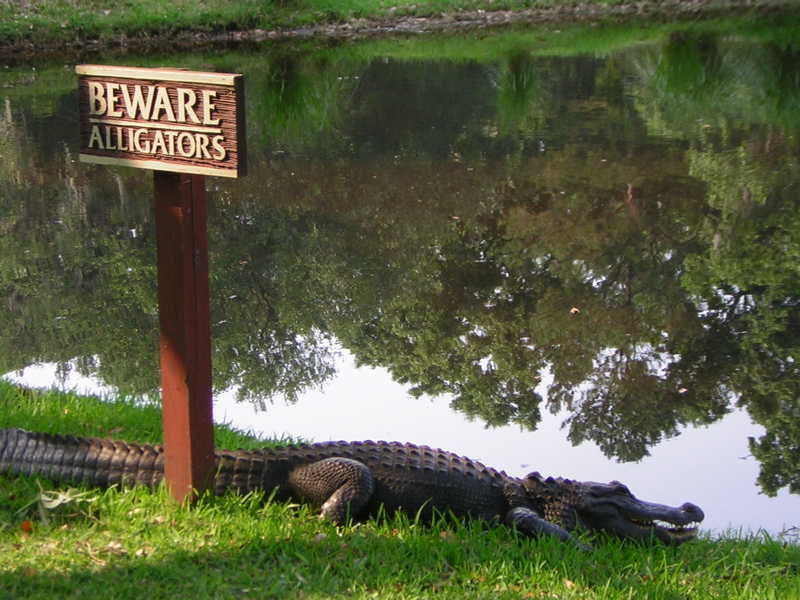
The drainage ditches—sorry, lagoons—are perfect habitat for alligators, creatures who like slow moving or still water, with easy access to land for sunning themselves or catching a few Z’s. In warm weather these antediluvian monsters are pretty well everywhere. It was cold when we were there—by HHI standards, though we Virginia Hillbillies thought it was pretty warm—so the gators were somnolent, but we did see a 4-footer out on the main highway that runs through the island. There's half a page in the HHI phone book that instructs you on how not to get eaten by an alligator, and the parking pass we received on the back warned us that:
"ALLIGATORS ARE DANGEROUS. Do not feed or provoke alligators or disturb alligator nesting sites... Do not throw objects at alligators... Enjoy alligators from a SAFE DISTANCE... Do not allow your children or pets to play near alligators... Alligators can move surprisingly fast over short distances... Alligators are usually passive when not provoked..."
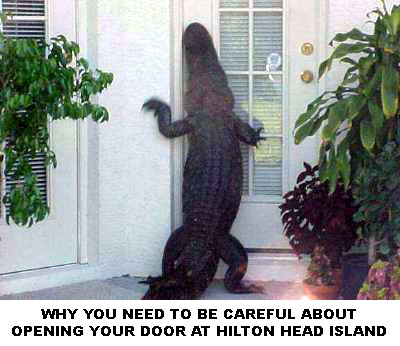 I was intrigued by that last line: "usually" passive. I’d bet that at times, especially on a warm day, even the most passive alligator, even were it a veritable reptilian Pacifist, would regard a poodle within lunging range as a "provocation" and suddenly decide that passivity is all very well, but…..it's dinner time. I have to wonder why anyone would consider owning property in a place where, quite literally, it is possible to find a 12-foot alligator in your front yard or your swimming pool (and yes, they can climb fences), but there it is: people do. HHI is a place where alligators are a normal and everyday hazard of life.
I was intrigued by that last line: "usually" passive. I’d bet that at times, especially on a warm day, even the most passive alligator, even were it a veritable reptilian Pacifist, would regard a poodle within lunging range as a "provocation" and suddenly decide that passivity is all very well, but…..it's dinner time. I have to wonder why anyone would consider owning property in a place where, quite literally, it is possible to find a 12-foot alligator in your front yard or your swimming pool (and yes, they can climb fences), but there it is: people do. HHI is a place where alligators are a normal and everyday hazard of life.
So, too, I imagine are snakes. Thank God, even in South Carolina, Christmas Week is usually far too cold for snakes to be very active, but if my years in Texas are anything to go by, I’d bet that from March to November, there isn't a place on the island where one could be certain never to encounter a snake. And HHI is far enough south that there have to be coral snakes, as well as the (marginally) less-dangerous varieties of poisonous reptiles typical of the American South. Perhaps they trade shifts with the alligators.
HHI is the most manicured place I have ever seen. "Manicured" is the only way to describe it. There isn't a blade of grass out of place, nor for that matter, one that's too long or too short. All of them are exactly the same length and in exactly the places they're supposed to be. There are many varieties of pine trees and palm trees and that signature tree of the coastal island, the palmetto: every single one of these trees is the right height for the place it's located, no higher nor lower than it is supposed to be. Every tree's height is dictated by the HHI Master Plan, and every tree is placed in such a way as to make the Law of Picturesqueness as effective as possible. A tree that exceeds its height is removed and transplanted somewhere else to make up for a tree that has failed in its duty and ended up too short.
The palmetto is an exceptionally well-mannered tree, perfectly suited to HHI. Its trunk is composed of a curiously interlaced set of fronds that spontaneously stub themselves off cleanly, making it look like a giant skinny pineapple. Smooth-trunked palms intersperse themselves with the palmettos at the proper distances and intervals to maintain The HHI Effect. And of course there are vast numbers of live oaks, draped with Spanish Moss (and, some day, perhaps the odd python). These oaks look every bit as old as they probably are. Many of the roads could easily have served as the driveway to Tara Plantation in "Gone With The Wind."
The streets on HHI are all in alphabetical order and are named in sets: one set of sea creatures; the next set one of birds; a third set named for various plants, every set in alphabetical order. Shopping center buildings are limited in size (one story, take it or leave it) and all buildings have to be painted one of the Official Hilton Head Island Colors. Everything on HHI is painted in these colors: re-painted in these colors every three to six months, too. Everything we saw clearly had been freshly painted. Owning a paint store on HHI would be like owning a mint, and you’d only have to stock four colors of paint.
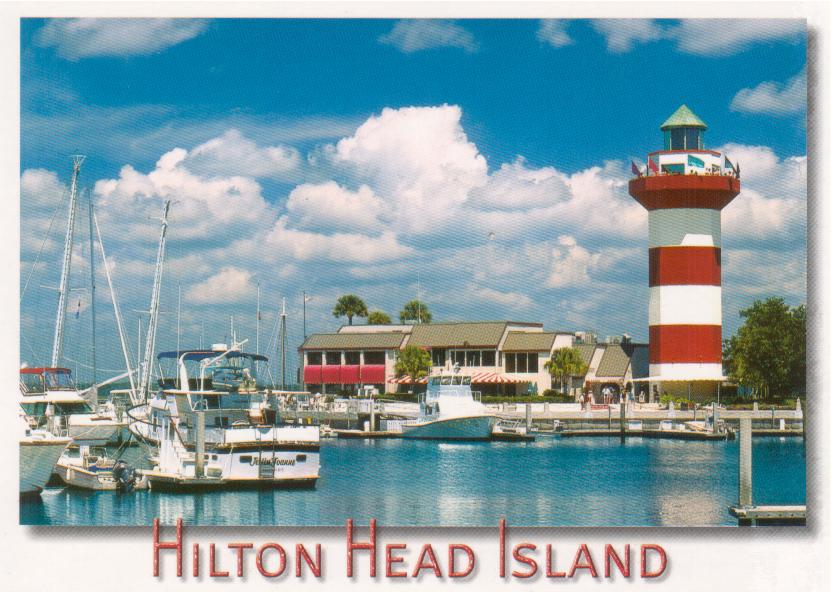 The advertising sign code on HHI is obviously not only Draconian in its terms, but in its enforcement. Along with first-degree murder, violating the Hilton Head Sign Code raises the specter of capital punishment. Signs must be no larger than a certain size; they have to be a certain distance from the road; cannot be above a certain height; and they have to be made of carved wood. Even Wal-Mart and gas station signs are made of carved wood: for that matter, traffic signs are made of carved wood. Like everything else on HHI, signs have to be painted in one of the Official Hilton Head Island Colors. The only exception I saw were wood stop signs painted the traditional red, and The Lighthouse, which is not, in fact a real lighthouse, though it looks like one. It's a "landmark" that was erected simply to add cachet to a local shopping center and marina, and it doesn't function at all. In fact, I don't think it can even be seen from the ocean!
The advertising sign code on HHI is obviously not only Draconian in its terms, but in its enforcement. Along with first-degree murder, violating the Hilton Head Sign Code raises the specter of capital punishment. Signs must be no larger than a certain size; they have to be a certain distance from the road; cannot be above a certain height; and they have to be made of carved wood. Even Wal-Mart and gas station signs are made of carved wood: for that matter, traffic signs are made of carved wood. Like everything else on HHI, signs have to be painted in one of the Official Hilton Head Island Colors. The only exception I saw were wood stop signs painted the traditional red, and The Lighthouse, which is not, in fact a real lighthouse, though it looks like one. It's a "landmark" that was erected simply to add cachet to a local shopping center and marina, and it doesn't function at all. In fact, I don't think it can even be seen from the ocean!
Since every commercial enterprise is in a low, small, beige building with virtually invisible signage, engulfed in abundant greenery, it's damned near impossible to find visual landmarks for anything you might want to get to. We went to the movies twice: the first time it took us about 15 minutes to find the shopping center in which it was located (half a mile from our “villa” and another 15 minutes after that to find the theater itself. The theater was cleverly camouflaged as a beige-colored building behind pastel-green palmettos. Every time we’d set out to find a restaurant the same thing happened. We'd spot one and decide to come back to it for dinner; but since everything looked the same and was obscured by foliage, finding it again that evening took a while. After a week it only took us 15 minutes to find something we'd seen at least three times, but had we stayed longer we'd have got it down to 10 minutes, easy.
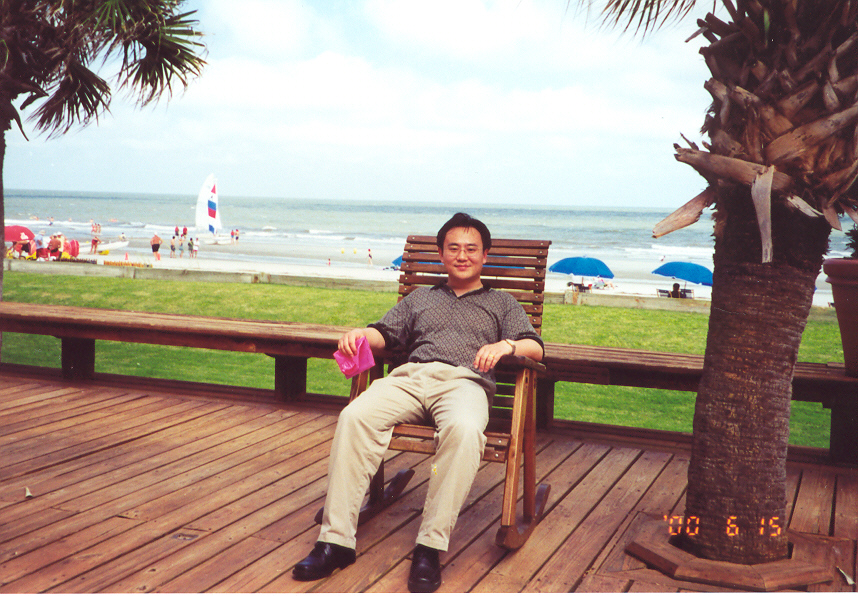 It takes work to maintain all this perfection. A veritable army of groundskeepers is needed, but luckily it is provided at very little expense by the generous and helpful nation of
It takes work to maintain all this perfection. A veritable army of groundskeepers is needed, but luckily it is provided at very little expense by the generous and helpful nation of
HHI also has to be the whitest place in South Carolina. I don't know what the racial composition of the state may be, but so far as we could tell, less than 0.01% of visitors were black. There were far more Sikhs and Chinese than blacks among the visitors. Blacks certainly work on HHI, but if any of them actually live there I’d be very surprised. There's a pretty obvious hierarchy of employment. The local black population has the better-paid semi-white-collar jobs (e.g., gate guards and store clerks) and the more menial chores of grounds maintenance are done by Mexicans. The mainland’s large pool of White Trash does plumbing and general repair work. There are surely some blacks who own property or rent as we did, because if you have enough Green, you become Economically, if not Epidermally, White. Nevertheless, I don’t remember seeing any.
The paperwork for our "villa" included a list of “fun things to do on HHI,” and also a list of things we were not permitted to do. Here is what you may do on HHI:
· Walk on the beach
· Play golf
· Play tennis
· Shop
· Eat at expensive restaurants
· Walk on the beach some more
So long as you refrain from feeding or provoking alligators by allowing your children or dog to get within lunging range, of course.
We were specifically told we could not do any of the following:
· Have animals on the beach between one week before Memorial Day and one week after Labor Day; and in the pet-permissible interval, only on a leash (this applied to cats as well as dogs)
· Play games involving “balls or other thrown objects”
· Throw any metal objects such as horseshoes (specifically named)
· Pick up live marine animals such as starfish and sand dollars
· Go fishing
Now, that last prohibition cheesed me off a bit. When we left I brought my surf rod, think that I'd get to do some surf casting when the boredom got too great. No such luck. Not only is fishing from the beach absolutely prohibited (by town ordinance!) there is almost nowhere on HHI where fishing is allowed. Furthermore, nowhere to buy tackle or bait. I needed some 25-pound-test line, but it took me a week to find a place that sold any sort of fishing gear. There was one convenience store with a pitiful collection, and that was it: and in this place you had to ASK for fishing tackle. This is nothing like Long Beach North Carolina: in Long Beach you buy fishing tackle in drug and grocery stores, which also sell live bait.
I'm not much on swimming in the sea, but I do enjoy fishing in shallow waters for whatever will eat stinky squid and salt-water minnows, and when we're at Long Beach I bring my boat and my friend Rick and I spend a lot of time in it. But on HHI, if you are so foolish and disgustingly low-brow as to want to fish in the first place, you have to do it from one of the four or five Officially Permitted Charter Boats. These boats will take you way the hell out into the ocean near the Gulf Stream, where fishing can be conducted clandestinely and no one will be offended by the sight of you doing so.
Nor, of course, is one allowed to do anything that might remotely be considered fun, if it involves fireworks, lawn darts, or guns. HHI is absolutely crawling with grey squirrels (except on the beach or in the apartment I was never out of sight of at least three at any given moment) and you'd think they'd want the population thinned out, but The Official Rules specifically forbid it. (The abundance of squirrels is proof that alligators don't eat them, though maybe the population explodes when the alligators are more or less dormant in winter.) Nor may you shoot an alligator that’s devouring your dog or toddler, because that would not only be a violation of the rule against hunting, it would (as the Rules book actually pointed out) be "baiting" under South Carolina's game laws!
The Official Hilton Head Island Vehicle is the Mercedes, though the occasional Volvo and Lexus are seen if the individual in question is cash-poor after buying one of those $750,000 apartments. The only permissible colors for automobiles are Sand Beige, Dead Sand Dollar Grey, Mackerel Pointe Blue, and Realtor® Maroon. Pickup trucks are permitted only if their list price is $55,000 or more. The Four Colors are acceptable for pickup trucks, but so is Givenchy Red. Porsches are welcome, Chevrolets are not. Mazdas are tolerated, but GMC's are forbidden. Cadillacs and Lincoln Continentals are permitted only if the driver is Economically White; and they must be painted Tolerated Black.
Mrs NRVO dragged me out on the beach for very long walks every day (I hate walking on the beach) and along the way, with a callous disregard of the rules against molesting dead or living marine animals, amassed an impressive collection of highly-illegal sand dollars and other assorted invertebrates.
You can only live in the Fast Lane so long: eventually we made two runs into Savannah. Long ago we'd watched the film Midnight In The Garden of Good and Evil, which is set in that city, and were interested in seeing it. Savannah’s nowhere near as large as I thought: about 130,000 people, maybe one-third again the size of Roanoke. Still, it does have an exceptionally picturesque Historical District. It's sort of like a bush-league New Orleans without the drunks. Mrs NRVO was disappointed that she didn't "...see more weird people..." but I, having been to New Orleans several times, have seen all the weird Southerners I want to in this life, and wasn’t complaining about a crackhead and loony-tune shortage in Savannah.
 We tracked down the cemetery where part of the movie was shot, which turned out to be a Catholic one on the edge of town, well outside the Historic District and in a not-especially-nice neighborhood. It was filled with Irishmen. (Dead ones, I mean.) Virtually every name on the headstones was Irish. If I’d been thinking about it, I suppose this shouldn't have surprised me, but it did.
We tracked down the cemetery where part of the movie was shot, which turned out to be a Catholic one on the edge of town, well outside the Historic District and in a not-especially-nice neighborhood. It was filled with Irishmen. (Dead ones, I mean.) Virtually every name on the headstones was Irish. If I’d been thinking about it, I suppose this shouldn't have surprised me, but it did.
This interesting little sidelight of Savannah’s history and of just how most of the Founders came to be there is nowhere mentioned in the tourist brochures. The commemorative marker at the site of James Oglethorpe's landing mentions the "colonists" who came with him and there’s an attractive bench monument on the site where “General Oglethorpe Rested On His First Night.” I’m sure the very dignified ladies of the United Daughters of the Confederacy who erected the marker aren't overly enthusiastic about reminding people of inconvenient facts regarding their origins.
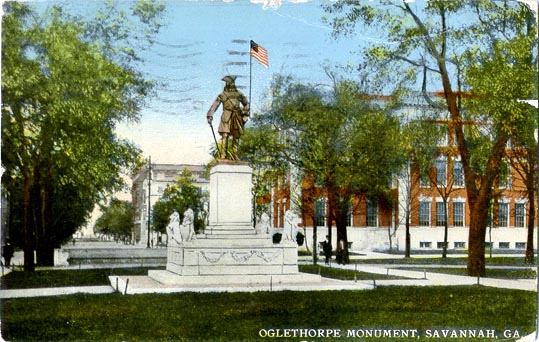 Savannah itself is "charming," at least the part we saw. It really is beautiful in the part that constitutes “downtown.” The streets are wide and laid out around squares lined with gracious old town houses. Among these are the homes of the founder of the Girl Scouts and the man who wrote "Jingle Bells." Honest to God: “Jingle Bells” was written in the Deep South. I wonder if the author ever saw snow in his life, let alone went riding in a one-horse open sleigh? We toured the home of one family who had been Prominent Citizens at one time, but whose home has inevitably been turned into a museum run by a tax-exempt Foundation because nobody can afford to pay the real estate taxes on these buildings. The house was the sort of place that a prosperous merchant would have lived in in the 1820's and 1830's, with every modern convenience of the time, including a two-seater outhouse. That was the only Historic Home open for viewing that day, but I don't think we missed out on much. See one Historic Home, you've seen them all.
Savannah itself is "charming," at least the part we saw. It really is beautiful in the part that constitutes “downtown.” The streets are wide and laid out around squares lined with gracious old town houses. Among these are the homes of the founder of the Girl Scouts and the man who wrote "Jingle Bells." Honest to God: “Jingle Bells” was written in the Deep South. I wonder if the author ever saw snow in his life, let alone went riding in a one-horse open sleigh? We toured the home of one family who had been Prominent Citizens at one time, but whose home has inevitably been turned into a museum run by a tax-exempt Foundation because nobody can afford to pay the real estate taxes on these buildings. The house was the sort of place that a prosperous merchant would have lived in in the 1820's and 1830's, with every modern convenience of the time, including a two-seater outhouse. That was the only Historic Home open for viewing that day, but I don't think we missed out on much. See one Historic Home, you've seen them all.
One of the places I wasn't allowed to visit was the Bass Pro Shops store, which Mrs NRVO said "...wasn't worth it..." though I would have found it a good deal more interesting than old houses and cemeteries. Oh, well, what the hell, I have their catalog. But I insisted on going to the Mighty Eighth Air Force Museum, a most interesting and impressive place dedicated to the history and memory of the men and machines who pounded the snot out of the Nazis, and shortly thereafter convinced the Japanese there was no point in further resistance. There weren’t as many aircraft on display as I could have wished, but there were a few, including a P-51 Mustang and a German rocket plane of a type I'd never seen before. There was a lot of memorabilia donated by ex-8th AFB members.
A museum like this one makes you look at people you know a little differently. My next door neighbor, kindly old George W, then in late 80's, was a pilot in the Eighth Air Force, flying B-17’s in the "shuttle-bombing" corridor between
| HUNTING | GUNS | DOGS |
| FISHING & BOATING | TRIP REPORTS | MISCELLANEOUS ESSAYS |
| CONTRIBUTIONS FROM OTHER WRITERS|
| RECIPES |POLITICS |